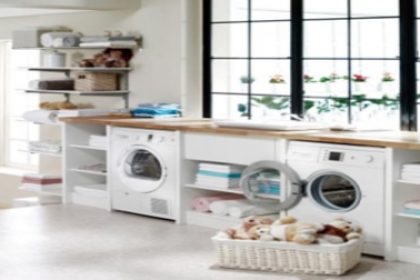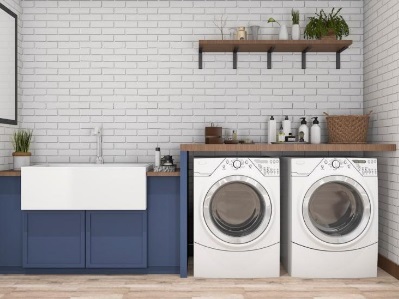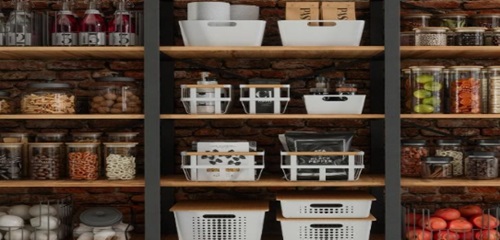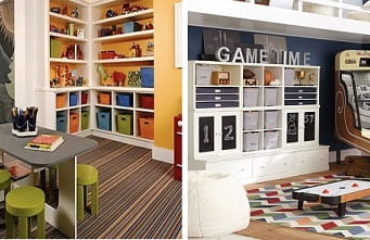
Moving and Organizing your laundry room and kitchen can greatly improve the functionality and efficiency of these spaces. Here are some specific tips for each area.
Organizing the Laundry Room:
- Declutter First: Start by going through your laundry room and removing any items you no longer need or use. This includes old detergents, empty containers, and items that don’t belong there.
- Sort Laundry Supplies: Categorize your laundry supplies like detergents, fabric softeners, stain removers, and bleach. Use canisters, bins or shelves with labels to keep these items organized and easy to access.
- Install Hooks and Racks: Install hooks or wall racks to hang laundry baskets, ironing boards, and other frequently used items. This will free up floor space and keep things organized.
- Fold and Sort Area: Create a designated space for folding and sorting laundry. A folding table or countertop can be helpful. Use laundry baskets or bins for sorting clothes by type (whites, darks, delicates).
- Maximize Vertical Space: The Laundry room should optimize your space with new heights. Utilize wall-mounted shelves or cabinets to make the most of vertical space. Store items like extra towels, cleaning supplies, and laundry-related tools. Strip lighting will add ambiance to your Utility room. Laundry sinks, pet rooms, florists areas, and mudrooms can enhance the look and functionality of your utility room.
Moving your Utility Room
- Disconnect your washer and dryer. Disconnect your dryer, washer and extra fridge before moving.
- Clean your washer and Dryer to get rid of dirt and buildup of detergent. You should clean your washing machine once a month. If you have a top loader, choose the clean cycle and use white vinegar in the bleach dispenser to clean the washer. A front loader is to be cleaned by choosing the hottest water temperature and longest cycle mixed with 4 cups of White Vinegar and 1 cup of bleach and run the cycle. A microfiber cloth with vinegar will clean the gasket that seals the door, soap dispensers and controls for both machines. Dryers can be cleaned by using soapy water to wipe down the drum, use dry cloth leave door open till dry. A vinegar spray bottle will eliminate orders in your dryer.
- Label all your boxes and be organized.
Organizing the Kitchen
- Declutter and Clean: Begin by decluttering your kitchen. Remove unused appliances, expired food, and items you no longer need. Give your kitchen a thorough cleaning. Declutter your junk drawer, kitchen table, countertops, duplicates, storage containers, front of your refrigerator, and old spices.
- Group Similar Items: Organize your kitchen cabinets and drawers by grouping similar items together. For example, store all your baking supplies in one cabinet and cooking utensils in another.
- Use Drawer Dividers: Drawer dividers can help keep utensils, cutlery, and kitchen gadgets neatly organized in drawers. Draw dividers bins are also great for refrigerators and Tupperware drawers.
- Pantry Organization: Arrange your pantry shelves with frequently used items at eye level and less-used items on higher or lower shelves. Use clear containers with labels for dry goods to easily see what’s inside. wooden bins are great to store can goods or boxed goods. Wire baskets are great to store fruits or vegetables. Water bottle storage and spice storage are great for organizing your pantry.
- Spice Rack: Consider a spice rack or drawer organizer to keep your spices easily accessible and organized.
- Under-Sink Storage: Utilize under-sink storage solutions like pull-out shelves or baskets to keep cleaning supplies and dishwashing materials organized.
- Pot and Pan and Cutting Board Storage: Use pot racks or pull-out drawer systems for pots and pans and cutting boards. This prevents stacking and makes them more accessible.
Moving your Kitchen Appliances
- Defrost your Fridge: Your extra fridge should be defrosted, cleaned out and disconnected. Hazardous material, perishable foods, and chemicals are not allowed for movers to take with them.
- Take Inventory: Make a list of all the items in your kitchen, including appliances, cookware, utensils, and food items. This will help you determine what to keep, donate, or discard.
- Pack Essentials Separately: Pack essential items separately and keep them accessible. These may include basic cookware, utensils, plates, and some food items for the first few days in your new kitchen. Use sturdy boxes and packing materials to protect fragile items like glassware and dishes. Wrap fragile items individually with bubble wrap or newspaper. Label your boxes with their contents and destination rooms to make unpacking easier. The kitchen is of the hardest rooms to pack.
- Disassemble Appliances: If you’re taking large kitchen appliances with you, like a refrigerator or oven, follow the manufacturer’s guidelines for disassembly and secure them properly for transportation.
- Hire Professional Movers: Consider hiring professional movers, especially for heavy or bulky kitchen appliances. They have the expertise and equipment to move them safely.
- Prepare Your New Kitchen: Clean and prepare your new kitchen before moving in. This includes ensuring all utilities are connected and functional for cooking and meal preparation.
- Safety Check: Check that all gas and electrical connections for appliances are properly set up to avoid any safety hazards.
- Stock Up: Once you’ve settled in, restock your kitchen with groceries and supplies to have everything you need for cooking and daily use. Enjoy Your New Kitchen.






